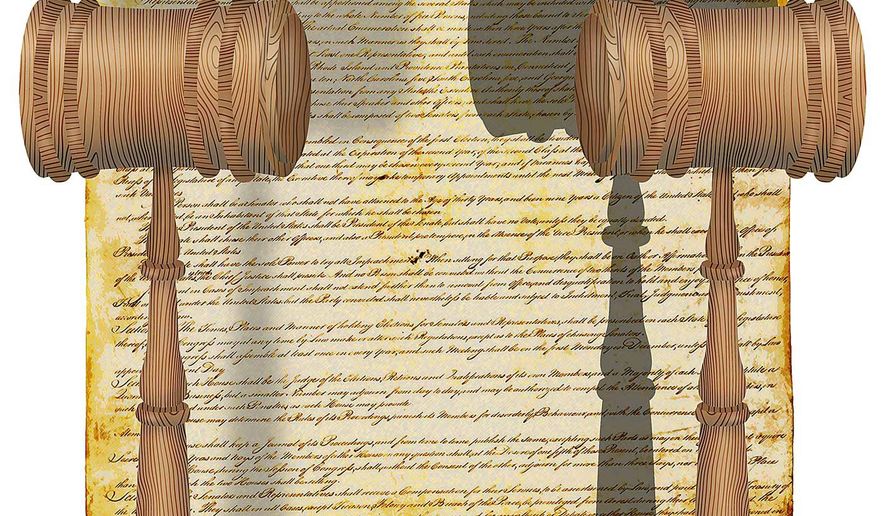OPINION:
Constitution Day falls on Sept. 17, the day in 1787 when the delegates to the Constitutional Convention in Philadelphia signed our founding document.
But this year we will be awash in paeans to the framers’ wisdom on Sept. 4, as the Senate begins confirmation hearings on President Donald Trump’s nominee to replace Justice Anthony Kennedy, Judge Brett Kavanaugh.
It’s worth remembering, before the members of the Judiciary Committee try to assess Judge Kavanaugh’s likely impact on constitutional law, that the labels we use to describe Executive and Legislative Branch politicians may not work quite so well when it comes to justices of the U.S. Supreme Court.
Consider Chief Justice John Roberts. Appointed by a Republican president, he is popularly seen as a conservative jurist. But he is not the same kind of conservative as his colleague, Clarence Thomas.
Justice Thomas believes that issues of constitutional interpretation can be resolved by judicial resort to the intent of the framers. The chief justice, on the other hand, has consistently recognized that history does not hold all the answers when the court seeks to understand and apply textual commands that are more than 200 years old (in cases involving our frame of government or the Bill of Rights), or 150 years old (in cases involving the Fourteenth Amendment’s guarantees of due process and equal protection of the laws).
In other words, Chief Justice Roberts has acknowledged that the court today is dealing with constitutional disputes the framers could not have contemplated — and that it should proceed with great care in resolving with these disputes. Thus he has often followed a pragmatic approach to constitutional interpretation.
Last term, for instance, Chief Justice Roberts wrote for the majority in United States v. Carpenter, which concerned the validity of government searches of cell phone location data. He rejected the argument that individuals always lose any privacy interest in information they have communicated to others.
The decision embraces the modern rule that the Fourth Amendment protects people, not places from government intrusion, by making clear that the implications of sharing information involuntarily with a cell service provider are not necessarily the same as when information is shared voluntarily with a friend or neighbor.
At bottom, Justice Roberts’ decision in Carpenter reflects the view that certain constitutional provisions, like the Fourth Amendment’s prohibition on unreasonable searches and seizures, must be interpreted in light of changed circumstances lest they become hollow promises.
At the same time, Chief Justice Roberts made clear in Carpenter that the court would go no further than the facts at hand, leaving for future litigation — and legislation — to determine the reach of the decision on the flow of personal information in our digitally-connected age.
In contrast to the chief justice, Justice Thomas, in his Carpenter dissent, did not just target the majority’s extension of the modern rule — rather, he challenged the rule itself. He maintained that the protection of people and not places itself reflects an interpretation of the Fourth Amendment that goes well beyond what the framers intended at the time they drafted that provision.
Had Justice Thomas prevailed, the decision would have upended decades of Fourth Amendment precedent.
As their respective opinions in Carpenter show, Chief Justice Roberts and Justice Thomas represent two different strains of “conservative” jurisprudence. The chief justice favors an approach that keeps the U.S. Constitution relevant by sanctioning constitutional change, albeit incremental.
This minimalist approach to the development of constitutional rules is the antithesis of the progressive jurisprudence of the 1960s-era Supreme Court, as Chief Justice Roberts seeks to protect the court’s legitimacy by steering its decision-making toward those channels in which it will leave the shallowest wake.
Justice Thomas, on the other hand, favors an ideological approach to constitutional interpretation that privileges a particular view of textual meaning above other considerations — including any perceived institutional obligation to ensure that the constitutional rules the court announces have some stability. This approach resembles the progressive constitutionalism of 50 years ago, to the extent that judicial restraint plays a significantly diminished role.
As we try to determine what the addition of Judge Kavanaugh will mean for constitutional law, we should be hoping that the members of the Senate Judiciary Committee understand these distinctive approaches to constitutional law.
We should hope, for example, that they ask Judge Kavanaugh not just whether he believes the Constitution protects a woman’s right to choose, but whether he believes it is in the court’s interest to overturn a 50-year-old precedent at the earliest opportunity — or, instead, to wait and see if, over time, it is appropriate for the judiciary to play such a definitive, and potentially divisive, role in American life.
• Lawrence Friedman is a professor of law at New England Law Boston and the author, most recently, of “Modern Constitutional Law.”




Please read our comment policy before commenting.